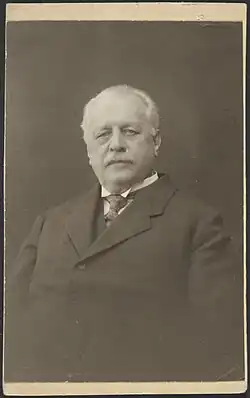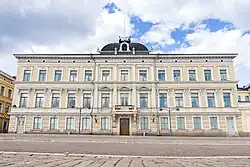Hugo Robert Standertskjöld
Hugo Robert Standertskjöld | |
|---|---|
 Hugo Robert Standertskjöld in 1915 | |
| Born | 24 September 1844 |
| Died | 9 May 1931 (aged 86) Helsinki, Finland |
| Occupation(s) | Colonel, arms manufacturer, industrialist, philanthropist |
| Known for | Development of Aulanko park, Finnish forest and paper industries, philanthropy |
| Awards | Order of Saint Vladimir, Order of Saint Stanislaus, Order of the Cross of Liberty |
Hugo Robert Standertskjöld (September 24, 1844 Janakkala, Grand Duchy of Finland – May 9, 1931 Helsinki, Finland) was a Finnish colonel, arms manufacturer, industrialist, and philanthropist best known for his significant contributions to industry and culture in Finland.[1][2][3][4]
Born into a Finnish noble family at the Vanantaka Manor in Janakkala, Standertskjöld followed his family’s military tradition by attending the Imperial Finnish Cadet School in Hamina. At a young age, he became an artillery officer and was soon assigned to the Tula rifle factory in Russia, where he was responsible for the technical production. His family had strong ties to arms manufacturing, as his uncle managed rifle factories in both Izhevsk and Tula.[1][2][3][4]
Standertskjöld eventually became the manager and major shareholder of the Izhevsk rifle factory, where he gained substantial business experience and amassed considerable wealth. Despite his success in Russia, he maintained strong ties to Finland, frequently spending time there and conducting business to support the Finnish army, including selling weapons at favorable terms.[1][2][3][5][6][4]
The transfer of Hugo Standertskjöld's money from Russia to Finland was a peculiar episode. He wanted to deposit his funds in the Bank of Finland, but the bank could not accept them. The bank did not have enough collateral for the assets. He bought, among other things, farms and became a farmer.[1][7][5]

Standertskjöld was also a prominent patron of the arts and education. He owned a private palace in Helsinki on Pohjoisesplanadi and in the 1880s acquired Karlberg manor in Hämeenlinna. There he developed the manor and its grounds into what is now known as the Aulanko park, an English landscape garden and forest park featuring exotic plants, artificial ruins such as Aulanko Castle, pavilions, and romantic structures. Aulanko became famous for its beauty and hosted many distinguished visitors.[1][3][7][8][5][4][9]
Standertskjöld imported the first Rolls-Royce into Finland, which was delivered to his summer manor Karlberg.[10]

Standertskjöld fell in love with a Polish countess, which is why he had the Karlberg manor built. Standertskjöld sent a speaker to the countess in Poland, and he sent plenty of gifts. The countess stated that she did not want to move to the northern coast of the Baltic Sea.[1][7]
After returning to Finland, he invested heavily in the forest and paper industries, notably purchasing and transforming the Kaukaa mills near Lappeenranta into a large cellulose-producing company, later part of the UPM Group. He also acquired vast forest estates to secure raw material supplies and promoted small-scale farming by offering favorable conditions to settlers on his lands.[1][3][6][4]
Known for his romantic personality, Standertskjöld was hospitable and culturally engaged. He supported local schools, founded a school for the children of his workers, and funded public services such as medical care. He was a notable donor to the White Army veterans after the Finnish Civil War and contributed generously to social causes.[1][3][11][4][12][9]
In 1926, he sold Karlberg and its surrounding lands to the city of Hämeenlinna, ensuring the preservation of the park's cultural values for future generations. Today, parts of his estate form the protected Aulanko Nature Reserve, a cherished natural and cultural landmark.[1][3][8]
Hugo Standertskjöld died unmarried in Helsinki in 1931, leaving behind a legacy as a military officer, industrial pioneer, and generous benefactor who shaped Finnish industry and cultural heritage in the late 19th and early 20th centuries.[1][3]
Awards
Hugo Standertskjöld received several notable awards during his lifetime. He was awarded the Order of Saint Vladimir, 4th Class Knight's Cross in 1885 by the Russian Emperor Alexander III. Later, he received the Order of Saint Stanislaus, 2nd Class Knight's Cross in 1899 from the Russian Emperor Nicholas II. Additionally, the Finnish Regent Carl Gustaf Emil Mannerheim awarded him the Order of the Cross of Liberty, 2nd Class, in 1918.[1][2]
References
- ^ a b c d e f g h i j k Pihkala, Erkki (9 October 2006). "Standertskjöld, Hugo Robert (1844 - 1931)". National Biography of Finland. Retrieved 20 August 2025.
- ^ a b c d "Standertskjöld nr 2126". Adelsvapen-Wiki (in Swedish). Retrieved 16 August 2025.
- ^ a b c d e f g h "Hugo Standertskjöldin muistolaatta ja muistokivi Aulangolla". Hämeenlinnan taidemuseo (in Finnish). Retrieved 16 August 2025.
- ^ a b c d e f "BLF". www.blf.fi. Retrieved 16 August 2025.
- ^ a b c "Matka | Upporikas ja onnettomasti rakastunut eversti ei tiennyt, mihin rahansa laittaisi – syntyi yksi Etelä-Suomen upeimmista retkikohteista, joka hämmästyttää yhä". Helsingin Sanomat (in Finnish). 7 August 2021. Retrieved 16 August 2025.
- ^ a b "Som Industrimän - Standertskjöld". www.standertskjold.fi. Retrieved 16 August 2025.
- ^ a b c "Aulanko on upporikkaan romantikon perintö jälkipolville". Yle Uutiset (in Finnish). 20 November 2013. Retrieved 16 August 2025.
- ^ a b Vaskimo, Anu (8 October 2020). "Aulangon upea puistometsä Hämeenlinnassa – Näin äveriäs Hugo Standertskjöld nosti tienoot loistoonsa ja jätti ne iloksi jälkipolville". Seura.fi (in Finnish). Retrieved 16 August 2025.
- ^ a b Karpiola, Saila (27 April 2021). "300 miestä hevosineen huhki, kun Hugo Standertskjöld rakennutti Aulangolle näkötornin – Eversti oli kaupungin väriläiskä, jonka juhlista ei lähdetty kuivin suin". Hämeen Sanomat (in Finnish). Retrieved 17 August 2025.
- ^ Viitamäki, Kari. "Hämeenlinna ja Aulanko" (PDF). Merkittävä matkailukohteet.
- ^ "Hugo Standertskjöld - Standertskjöld". www.standertskjold.fi. Retrieved 16 August 2025.
- ^ Kurjensaari, Matti: Elävä Aulanko : Aulanko 100 v. Rantasipi Oy, 1983 Jyväskylä.